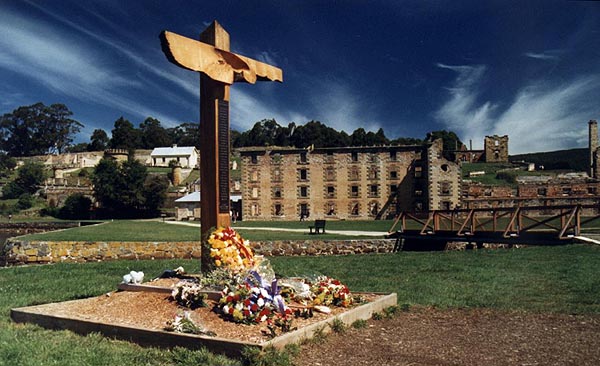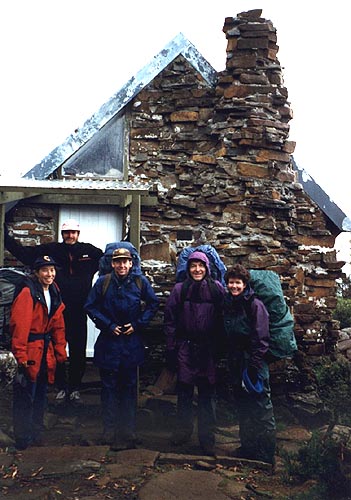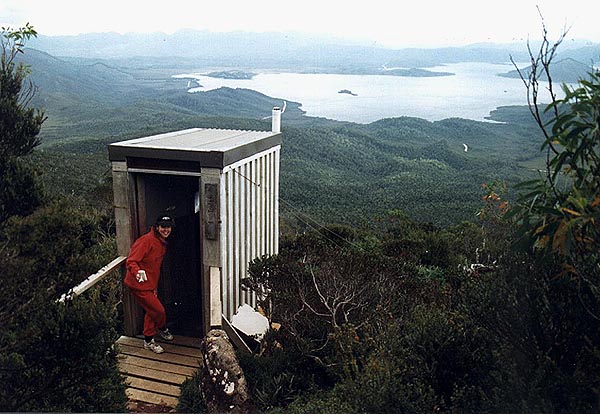|
Karen and I bussed into Hobart and set up camp at the Sandy Bay caravan park, a few kilometres south of the town centre near the Casino. We had been to Hobart on our previous trip to Tasmania and done all the usual tourist things like Mount Wellington and the Botanic Gardens and tours out to Richmond, the Tasman Peninsula and the old penal settlement of Port Arthur. Our bus pass, however, came with a free day trip to Port Arthur, and despite having been there before, we decided to take advantage of the offer and go again.
We had a perfect day for the tour, warm with a deep blue sky. All the usual tourist spots were visited along the way, including Do Town where every house has a name like It'll Do or Howdya Do. We also visited a few of the spectacular scenic attractions of the Tasman Peninsula coast, like Tasman's Arch, the Devil's Kitchen and The Blowhole. A sign at the latter had me laughing when it warned "Beware - freak waves are common"!
Apart from the fact that the tour was free and the scenery and history exceptional, our main reason for wanting to return to Port Arthur was morbid curiosity. Since our last visit, the site had witnessed the massacre of thirty five people by a crazed gunman, and we were curious to see how Port Arthur had been affected. During the cycling legs of our travels, Karen and I were constantly aware of the possibility of attack by insane strangers. When camping in remote areas we had always taken great care to ensure that the highway was deserted before heading off-road for the night, and once at our campsite we would give no indication of our presence - no fires, no lights, no noise. We knew that the possibility of an attack by a crazy person was slight, but incidents like the Backpacker murders and the Port Arthur massacre made us realise that the possibility was very real.
It was a very weird feeling to have lunch near the restaurant where most of the victims had died. It was strange to see areas boarded up and to know that evil deeds had been done beyond those walls. It was bizarre to look around at all the other people calmly having their lunch and wonder whether any of them might be about to pull out a weapon and go on a killing spree.
Apart from the reconstruction of the restaurant, there was nothing to remind visitors of the senseless destruction of human life which had occurred at Port Arthur, except for a simple memorial to the people who had died. Neither the massacre nor the man responsible for it were mentioned anywhere, the memorial existing to perpetuate the memory of the people who had died and not to glorify the act which had caused their deaths.

The Port Arthur Memorial
Karen and I had not come to Tasmania to look at the cities or witness insanity, so we were soon off into the wilds of the national parks again. David from Launceston had recommended a walk to Mount Anne, the highest mountain in the Tasmanian south-west. Tyrone Thomas in his book "100 Walks in Tasmania" describes Mount Anne as attracting "the true bushwalker" and says "it is a peak to be respected for two reasons - it can be subject to absolutely foul weather conditions with intense exposure problems and there are two sections of the climb which are extremely rocky and steep." It sounded great.
The bus deposited us at a carpark near the shore of Lake Pedder at the start of the walk. It would not return for another two days, so if any accidents happened, help would not be available for quite some time. The walking track climbs from the car park up to a small hut just below one thousand metres, then continues on to the Eliza Plateau and Mount Eliza at almost thirteen hundred metres. A traverse across the plateau for a couple of kilometres leads to the climb up to Mount Anne. Karen and I planned to reach the hut on the first afternoon, climb Mount Eliza and Mount Anne on the second day, then walk back down to the bus on the third day. Things, however, did not go according to plan.
The weather was cool and overcast as we started the climb - perfect hiking weather. On a level section at the top of the first major rise, we flushed a bird from the stunted heath beside the track. It flew only about twenty metres before landing in plain view. Karen and I quickly whipped out our binoculars to get a perfect sighting of a new and rare bird - the ground Parrot. We were stoked.
A glance behind us showed dark, menacing clouds moving in across Lake Pedder. Pretty soon we were hit by a couple of icy showers. We donned our rain jackets and continued upwards, reaching the hut a little over an hour after starting out. We were lucky that nobody else was in residence, because despite its two storeys, the hut is tiny. Four people could sleep shoulder to shoulder in the top section, and about the same number on the floor and seats down below.
A thousand metres up a south-west Tasmanian mountain is a cold place to be. The Roaring Forties whipped in across the lake from the ocean and kept the air temperature somewhere near zero. The heat Karen and I had generated during the climb soon disappeared, so during a break in the weather I suggested that we stay warm by climbing the final few hundred metres up to Mount Eliza. The altitude and exertion must have temporarily deranged me, because right now I can think of a much more enjoyable way of staying warm, without even having to leave the hut! Unfortunately, I did not even consider this option.
The track above us to the summit of Mount Eliza was one of the steep, rocky sections mentioned by Tyrone Thomas in his book. In snow or icy conditions it might have been tricky, but in the current benign conditions, Karen and I found the scramble fairly straightforward.
Mount Eliza is a trig-topped bump on the south end of the plateau. A thousand metres below and four or five kilometres westwards lies the expanse of Lake Pedder. The Western Arthurs - home of the most dangerous and exposed walk in all of Australia - were visible on the horizon to the south. Although not too many kilometres away, they looked like they were copping far worse weather than we were. Karen and I walked a little way south-east of the summit to gaze down at the waters of Lake Judd, six hundred vertical metres directly below us. To the north, the summit of Mount Anne was shrouded in cloud. As we watched, the cloud layer began to descend, and Karen and I decided to do the same.
Another couple arrived at the hut in the late afternoon, with the female bearing an uncanny resemblance to the Australian singer, Julie Anthony. The male, not to be outdone, showed us his watch, which was also a thermometer, a barometer and an altimeter, and cost many a dollar. We passed a cold, uncomfortable but tightly packed night in the top floor of the hut, packed in like Bob and Carol, Ted and Alice.

The hut below Mount Eliza
Karen and I were soon left alone in the morning to decide our day. The weather had worsened, with the cloud level hovering at hut level, its base shredded by the strong wind. We could not go up because of the conditions. Down was a possibility, but with the bus not retrieving us until tomorrow, we would only be going down to a wet night in the tent. Inertia overcame us, and we decided to stay where we were, hoping the weather would suddenly clear to give us a chance to go for the summit of Mount Anne.
Our hopes came to nothing. The weather was crook all day, and cold. To stay warm, we intermingled extended stays inside the sleeping bag, fully dressed, with regular cups of hot coffee. I even resorted to running on the spot, doing sets of push-ups and trying a few chin-ups in the hatchway at the top of the ladder leading to the top floor.
The cold, inactivity and endless cups of coffee had a profound effect on our bladders, with each coffee break soon followed by a dash along a short, rocky path down to dunny perched on the side of the hill. These trips were not unwelcome, because the view through the dunny window was spectacular, easily the best dunny view in Australia!

The dunny and its spectacular view
Conditions were still bad on our final morning at the hut. We resigned ourselves to a walk down the mountain in the rain. Our summit attempt was aborted but we were thankful that we had at least climbed up to the plateau on the first afternoon when conditions had been only passable at best. We were also thankful for the presence of the hut. Shelter makes harsh environments so much easier to tolerate.
Karen and I had gained a valuable insight into what to expect in Tasmanian mountains. Any thoughts I had of tackling the Western Arthurs on this trip soon died a horrible and painful death. We simply did not have the experience or equipment for extended forays into high altitude areas famous for their exposure to the elements. Neither Karen nor myself liked cold weather either. We could suffer it in small daily doses, but only while our nights were dry, and preferably warm. Basically, we are fair weather walkers.
We are also wimps.
|


